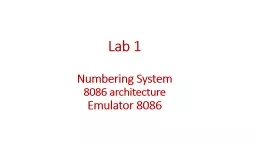

architecture Emulator 8086 Hexadecimal System Hexadecimal System uses 16 digits 0 1 2 3 4 5 6 7 8 9 A B C D E F And thus the base is 16 Note Hexadecimal numbers are compact and easy to read ID: 787088
Download The PPT/PDF document "Lab 1 Numbering System 8086" is the property of its rightful owner. Permission is granted to download and print the materials on this web site for personal, non-commercial use only, and to display it on your personal computer provided you do not modify the materials and that you retain all copyright notices contained in the materials. By downloading content from our website, you accept the terms of this agreement.
Slide1
Lab 1
Numbering
System
8086
architecture
Emulator
8086
Slide2Hexadecimal System
Hexadecimal
System uses
16 digits
:
0
, 1, 2, 3, 4, 5, 6, 7, 8, 9, A, B, C, D, E,
F
And thus the
base
is
16
.
Note:
Hexadecimal numbers are compact and easy to read.
It is very easy to convert numbers from binary system to hexadecimal system and vice-versa, every nibble (4 bits
)
Slide3converted to a hexadecimal digit using this table:
Slide4There is a convention to add
"h" in the end of a hexadecimal number, We also add
"0"
(zero) in the beginning of hexadecimal numbers that begin with a letter (A..F), for example
0E120h
.The hexadecimal number 1234h is equal to decimal value of 4660:
Hexadecimal System
Slide5Converting from Decimal System to
Other
System
In order to convert from decimal system, to any other system, it is required to divide the decimal value by the
base
of
the desired system, each time you should remember the result and keep the remainder, the divide process continues until the
result
is zero.
The
remainders
are then used to represent a value in that system.
Let's convert the value of
39
(base 10) to
Hexadecimal System
(base 16):
Slide6As you see we got this hexadecimal number:
27h
.
Converting from Decimal System to
hexa
.
Slide7let's convert decimal number
43868 to hexadecimal form:
Converting from Decimal System to Any Other
Slide8420.625
10
=
420.625
10
= 420
10
+ .625
10
Division
Quotient
Remainder 420 ÷ 16 26 4 26 ÷ 16 1 10 (or A) 1 ÷ 16 0 1 Multiplication Product Carry-out .625 x 16 10.000 10 (or A)420.62510 = 1A4.A16413510 = 102716625.62510 = 271.A16
Converting from Decimal System to Any Other
Slide9Convert
Hexa
.
to
Binary
number
Slide10Number Systems
Binary-Coded Hexadecimal (BCH):
2AC = 0010 1010 1100
1000 0011 1101 . 1110 = 83D.E